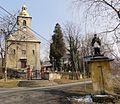Leszna Górna
| Leszna Górna | ||
|---|---|---|

|
|
|
| Basic data | ||
| State : | Poland | |
| Voivodeship : | Silesia | |
| Powiat : | Cieszyn | |
| Gmina : | Goleszów | |
| Area : | 9.06 km² | |
| Geographic location : | 49 ° 42 ' N , 18 ° 44' E | |
| Residents : | 540 (2014) | |
| Postal code : | 43-445 | |
| Telephone code : | (+48) 33 | |
| License plate : | SCI | |
Leszna Górna (originally Leszczna , also Niemiecka Leszczna ; German Ober Lischna ; Czech Horní Líštná ) is a village with a school administration of the municipality of Goleszów in the powiat Cieszyński of the Silesian Voivodeship in Poland .
geography
Leszna Górna is located on the border of the Silesian Foothills ( Pogórze Śląskie , in the north-west) and the Silesian Beskids ( Beskid Śląski , in the south-east) about 25 km southwest of Bielsko-Biała and 65 km south of Katowice in the powiat (district) Cieszyn.
The village has an area of 906 ha .
Neighboring towns are Dzięgielów and Cisownica in the north, the city of Ustroń in the east, the Czech Republic in the west (the city of Třinec ), south ( Vendryně ) and south-east ( Nýdek ).
history
The village is located in the Olsa area (also Teschener Silesia , Polish Śląsk Cieszyński ).
The place was first mentioned in a document around 1305 in the Liber fundationis episcopatus Vratislaviensis (tenth register of the diocese of Breslau ) as " Item in Lesna principis XX mansi solventes ". The name is derived from hazelnuts (Polish leszczyna , Teschener dialect lyska ). The original adjective principis (German princely ) is to be distinguished from the knightly Lesna Snessonis (today Dolní Líštná in the Czech Republic). Later it was mentioned in 1457 as Nemeczsk [a] Lessczn [a] (literally German Leschna , according to Magdeburg law ), in 1523 as Lessczna Wirhny .
Politically, the village originally belonged to the Duchy of Teschen , which existed from 1290 during the period of Polish particularism . Since 1327 consisted suzerainty of the Kingdom of Bohemia and since 1526 it belonged to the Habsburg monarchy .
The parish of Lezna was mentioned in the Peterspfennigregister of the year 1335 in the Teschen deanery and in 1447 as Lesna .
After 1540 under Wenceslaus III. Adam the Reformation and the Church was taken over by Lutherans. A special commission returned them to the Catholics on March 21, 1654.
After the abolition of patrimonial it formed a municipality in Austrian Silesia , Teschen district and judicial district Teschen from 1850 . In the years 1880 to 1910 the population increased from 744 in 1880 to 870 in 1910, there were predominantly Polish speakers (between 99.2% and 100%), in 1880 there were also 12 (1.3%) German speakers. In 1910 64.8% were Protestant, 34.6% Roman Catholic, there were 5 Jews.
In 1920, after the collapse of the Austro-Hungarian monarchy and the end of the Polish-Czechoslovak border war , Leszna Górna came to Poland. Part of the village was found in the Czech Republic ( Horní Líštná , Třinec ). This was only interrupted by the occupation of Poland by the Wehrmacht in World War II .
From 1975 to 1998 Leszna Górna belonged to the Bielsko-Biała Voivodeship .
religion
The Catholic parish belongs to the Bielsko-Żywiec diocese , Goleszów deanery. The evangelical branch parish belongs to the parish of Goleszów, diocese of Cieszyn .
Personalities
- Josef Koždoň (1873–1949), a politician and long-time mayor of Czech Teschen (Český Těšín)
Web links
Individual evidence
- ↑ a b c Robert Mrózek: Nazwy miejscowe dawnego Śląska Cieszyńskiego . Uniwersytet Śląski w Katowicach , 1984, ISSN 0208-6336 , p. 104 (Polish).
- ↑ Marcin Żerański: Śląsk Cieszyński od Bielsko-Białej do Ostrawy. Przewodnik turystyczny . Pracownia na Pastwiskach, Cieszyn 2012, ISBN 978-83-933109-3-7 , p. 264 (Polish).
- ↑ Gmina Goleszów: UCHWAŁA NR XXXIX / 326/10 RADY GMINY GOLESZÓW z dnia 24 lutego 2010 r. w sprawie programu gospodarczego p / n: Plan odnowy miejscowości Leszna Górna na lata 2010 - 2016 ( pl ) In: www.goleszow.bip.net.pl . 2010.
- ^ Idzi Panic: Śląsk Cieszyński w średniowieczu (do 1528) . Starostwo Powiatowe w Cieszynie, Cieszyn 2010, ISBN 978-83-926929-3-5 , p. 297-299 (Polish).
- ^ Wilhelm Schulte: Codex Diplomaticus Silesiae T.14 Liber Fundationis Episcopatus Vratislaviensis . Breslau 1889, ISBN 978-83-926929-3-5 , p. 110-112 ( online ).
- ↑ Liber fundationis episcopatus Vratislaviensis ( la ) Retrieved August 24, 2014.
- ↑ January Ptaśnik: Monumenta Poloniae Vaticana T.1 Acta Apostolicae Camerae. Vol. 1, 1207-1344 . Sums. Academiae Litterarum Cracoviensis, Cracoviae 1913, pp. 366 ( online ).
- ^ Registrum denarii sancti Petri in archidiaconatu Opoliensi sub anno domini MCCCCXLVII per dominum Nicolaum Wolff decretorum doctorem, archidiaconum Opoliensem, ex commissione reverendi in Christo patris ac domini Conradi episcopi Wratislaviensis, sedis apostolice collectoris, collecti . In: H. Markgraf (Ed.): Journal of the Association for History and Antiquity of Silesia . 27, Breslau, pp. 361-372. Retrieved July 21, 2014.
- ^ Jan Broda: Z historii Kościoła ewangelickiego na Śląsku Cieszyńskim . Dom Wydawniczy i Księgarski "Didache", Katowice 1992, ISBN 83-8557200-7 , Materiały do dziejów Kościoła ewangelickiego w Księstwie Cieszyńskim i Państwie Pszczyńskim w XVI i XVII wieku, p. 259-260 (Polish).
- ↑ Kazimierz Piątkowski: Stosunki narodowościowe w Księstwie Cieszyńskiem . Macierz Szkolna Księstwa Cieszyńskiego, Cieszyn 1918, p. 263, 281 (Polish, opole.pl ).
- ↑ Ludwig Patryn (ed): The results of the census of December 31, 1910 in Silesia , Opava 1912.
- ↑ Dz.U. 1975 no 17 poz. 92 (Polish) (PDF file; 783 kB)



